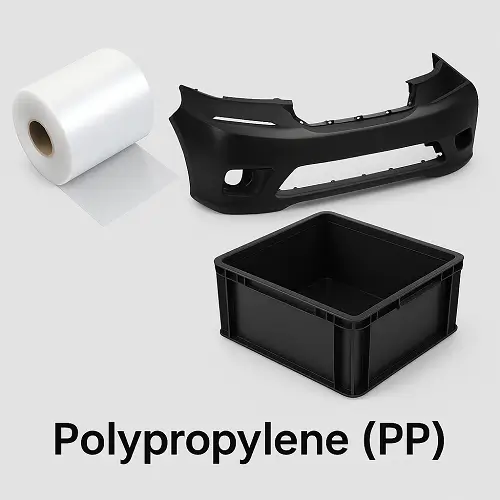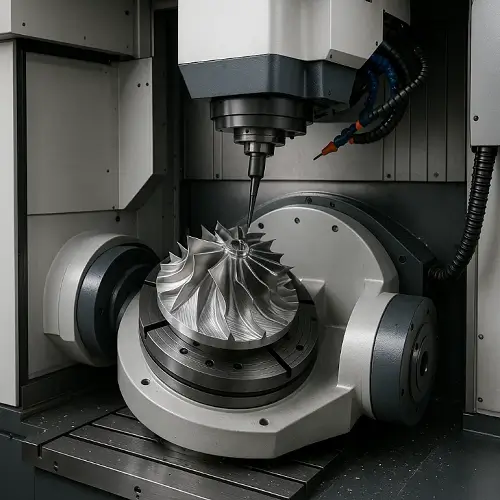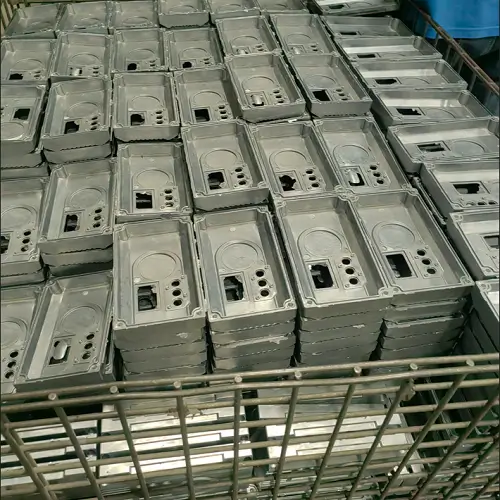Polypropylene (PP) is currently the second most used thermoplastic polymer in the world, after polyethylene (PE). Due to its low density, chemical resistance, recyclability and cost-effectiveness, PP has become one of the most commonly used general engineering plastics in manufacturing.
Whether it’s packaging film, automotive bumpers, medical devices and chemical piping, polypropylene materials are lightweight and strong in a variety of industries.
According to PlasticsEurope, polypropylene accounts for more than 20% of global plastics production. With its simple molecular structure and flexible design, it is one of the polyolefin materials with the greatest scope for modification.

What is Polypropylene (PP)
Polypropylene is a semi-crystalline polymer. Its ability to crystallize is closely related to its core type, isotactic polypropylene. In the iso-gauge structure, methyl side groups are regularly arranged on one side of the molecular chain, allowing the molecular chain to be tightly and regularly stacked to form crystalline regions. This high degree of crystallinity directly contributes to the higher rigidity, strength and heat resistance of PP. PP cannot be viewed as a monolithic material, but rather as a platform of materials whose properties can be tailored through molecular design.
It can only be said that the success of polypropylene lies in its excellent balance of performance, processability and cost. It is more heat-resistant and rigid than PE; tougher than PS; and less costly than many engineering plastics. This unique combination of advantages makes it one of the materials of choice for achieving product lightweighting, durability and cost control.
Polypropylene (PP) Chemical Formula
Polypropylene is a semi-crystalline polymer formed by the polymerization of propylene monomer (C₃H₆) in the presence of a catalyst, and its molecular structure can be expressed as follows:
Polymerization reaction formula:
C₃H₆ → (-CH₂-CH(CH₃)-)ₙ
The methyl group (-CH₃) on the side group of the molecular chain enhances the ability of the molecular chain to regularize its arrangement, resulting in a higher degree of crystallinity of polypropylene, which is superior to polyethylene in terms of mechanical strength and heat resistance.
Types by Stereo Configuration
In terms of stereo configuration, polypropylene is divided into three main categories:
-
Isotactic PP: Methyl groups are located on the same side of the molecular chain and are most widely used for their high crystallinity and strength.
-
Syndiotactic PP: Methyl groups are alternately arranged on both sides of the chain, making the material more flexible.
-
Atactic PP: The methyl group is irregularly arranged, basically non-crystalline, commonly used in coatings or modified base materials.
Production and Processing of Polypropylene
Polypropylene is usually produced industrially using a low pressure catalytic polymerization process. The polymerization of propylene gas occurs under the action of a Ziegler-Natta catalyst or a metallocene catalyst, and different catalytic systems can regulate the molecular weight distribution, conformational regularity, and copolymer composition of the polypropylene.
The polymerized PP resin is typically supplied in pellet form and can be molded by the following common processes:
-
Injection Molding: Suitable for automotive parts, appliance housings and medical devices.
-
Extrusion: For the manufacture of sheet, film, pipe, etc.
-
Blow Molding: The production of hollow containers such as bottles, tanks and so on.
-
Spinning (Fiber Spinning): For the manufacture of non-woven fabrics, woven bags and filtration materials.
PP is usually processed at temperatures between 180-240°C, with a molding shrinkage of about 1.5%-2.0%. To avoid warpage, cooling rates and mold temperatures need to be strictly controlled.
Key Properties of Polypropylene
Polypropylene is a semi-crystalline thermoplastic that combines rigidity and toughness, and its overall properties are shown in the table:
| Properties | Typical Values | Description |
|---|---|---|
| Density (g/cm³) | 0.90-0.91 | Lowest density of any thermoplastic, which facilitates lightweighting |
| Tensile Strength (MPa) | 25-40 | Significantly affected by crystallinity |
| Flexural Modulus (MPa) | 1200-1600 | Characterizes rigidity of material |
| Elongation at break (%) | 200-700 | Excellent toughness, resistant to repeated bending |
| Melting point (°C) | 160-170 | Higher than polyethylene, can be used in high-temperature environments |
| Heat deflection temperature (°C) | 95-110 | Long-term use up to 100°C |
| Water absorption (%) | <0.01 | Very low, good dimensional stability |
| Surface energy (mN/m) | 30-31 | Highly inert surface, needs treatment before painting and bonding |
| Coefficient of linear expansion (×10⁻⁵/K) | 12-15 | Processing needs to be designed to take thermal expansion into account |
| Standard references | ASTM D638 (Tensile), ASTM D790 (Flexural) | — |
Major Types of Polypropylene
| Type | Molecular Structure and Characteristics | Performance Characteristics | Typical Uses |
|---|---|---|---|
| PP-H (homopolymerization) | Pure propylene polymerization, high crystallinity | Good stiffness, excellent chemical resistance | Chemical piping, machinery shells, fiber products |
| PP-R (random copolymerization) | Introduction of random copolymerization units of ethylene | Good toughness, high transparency | Hot water pipes, food packaging, medical supplies |
| PP-B (block copolymerization) | Ethylene forms a block structure | Good impact resistance, especially at low temperatures | Automotive bumpers, crates, outdoor equipment |
Key Properties Summary
Polypropylene is well balanced in terms of mechanical, thermal, electrical and chemical stability:
-
Mechanical properties: High crystallinity provides good rigidity and fatigue resistance, making it suitable for parts that require repeated bending, such as living hinges.
-
Thermal properties: Melting point of approx. 165°C, heat distortion temperature of more than 100°C, resistance to steam sterilization.
-
Chemical stability: Stable to most acids, alkalis and organic solvents, and not affected by humidity.
-
Electrical properties: Low dielectric constant, high volume resistivity, ideal for electrical insulation.
-
Environmental and Recycling: Fully recyclable with a #5 recycling label, it is highly economical and sustainable.
Polypropylene vs. Polyethylene
| Item | Polypropylene (PP) | Polyethylene (PE) |
|---|---|---|
| Density (g/cm³) | 0.90-0.91 | 0.91-0.97 |
| Melting Point (°C) | 160-170 | 105-135 |
| Rigidity | Higher | Moderate |
| Flexibility | Moderate | Excellent |
| Heat Resistance | Better | General |
| Chemical stability | Excellent | Excellent |
| Impact resistance | Medium | Good |
| Cost | Similar | Similar |
| Typical uses | Structural components, hot water pipes, containers | Films, packaging, piping |
Typical Applications for Polypropylene
Polypropylene products unify lightweighting and low cost in a number of industries:
-
Packaging industry: Food containers, bottle caps, woven bags, films.
-
Automotive industry: Bumpers, instrument panels, battery cases, interior components.
-
Home Appliances & Household Goods: Organizers, home accessories, toys, furniture.
-
Medical & Laboratory: Syringes, sample bottles, centrifuge tubes, etc.
-
Chemical & Engineering: Anti-corrosion tanks, valves, drains and protective linings.
Frequently Asked Questions (FAQ)
Q1: What is the melting point of polypropylene?
Generally in the range of 160-170°C, depending on crystallinity and copolymerization components.
Q2: Can polypropylene be CNC machined?
Yes, but it is recommended to use sharp cutting tools, low speeds and cooling to avoid softening of the material or the creation of flying edges.
Q3: Does polypropylene meet food-grade safety standards?
Food-grade PP meets FDA and EU regulations and is commonly used in food packaging and drinking water systems.
Q4: Does polypropylene become brittle at low temperatures?
No. Impact strength decreases at low temperatures. For use in low-temperature environments, it is recommended to use block copolymerized PP-B or toughened modified grades.
Q5: Is polypropylene recyclable?
It is fully recyclable, with recycling symbol #5. Recycled material can be used in injection molded products, piping and other non-pressurized parts.
About JeekRapid
JeekRapid specializes in custom manufacturing services for polypropylene (PP) and other thermoplastic engineering plastics, including injection molding, extrusion, thermoforming and CNC precision machining.
Our technical team is able to recommend the most appropriate PP material type and molding solution based on the customer’s product environment, mechanical loading and appearance requirements.
Whether you’re prototyping or producing on a large scale, JeekRapid can ensure performance while optimizing cost control. Click on us to get a quote and we’ll get back to you within 24 hours!


